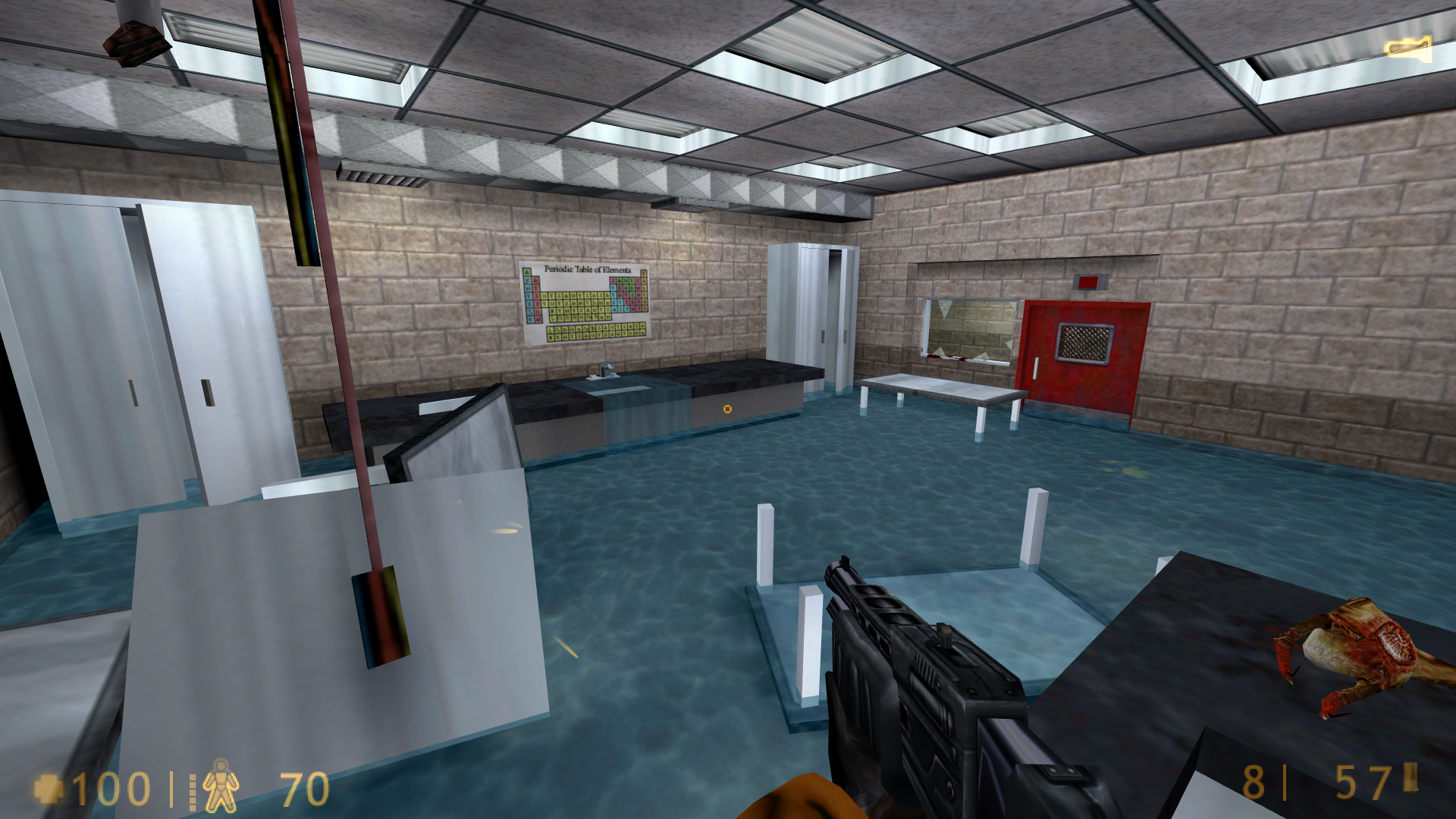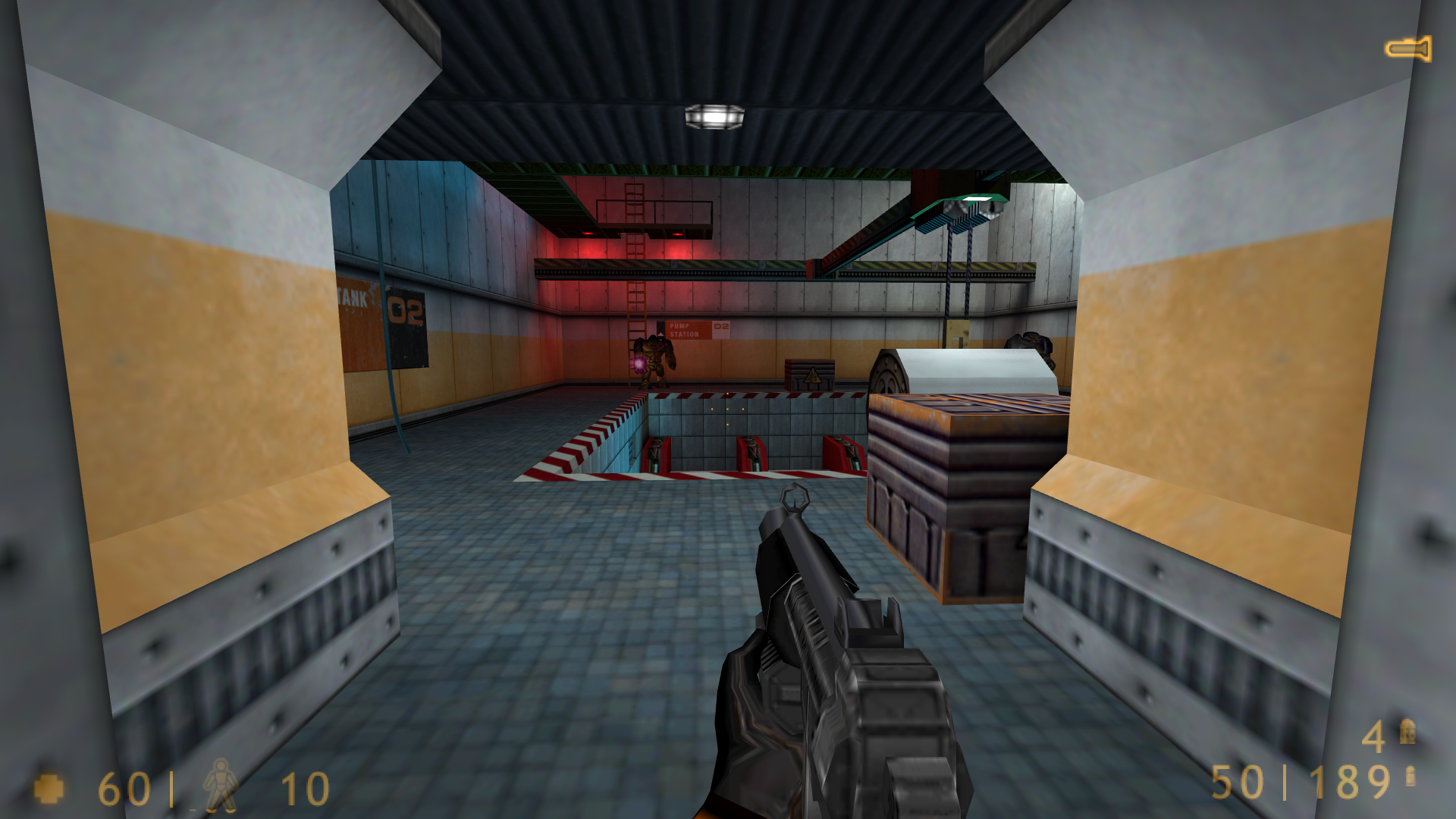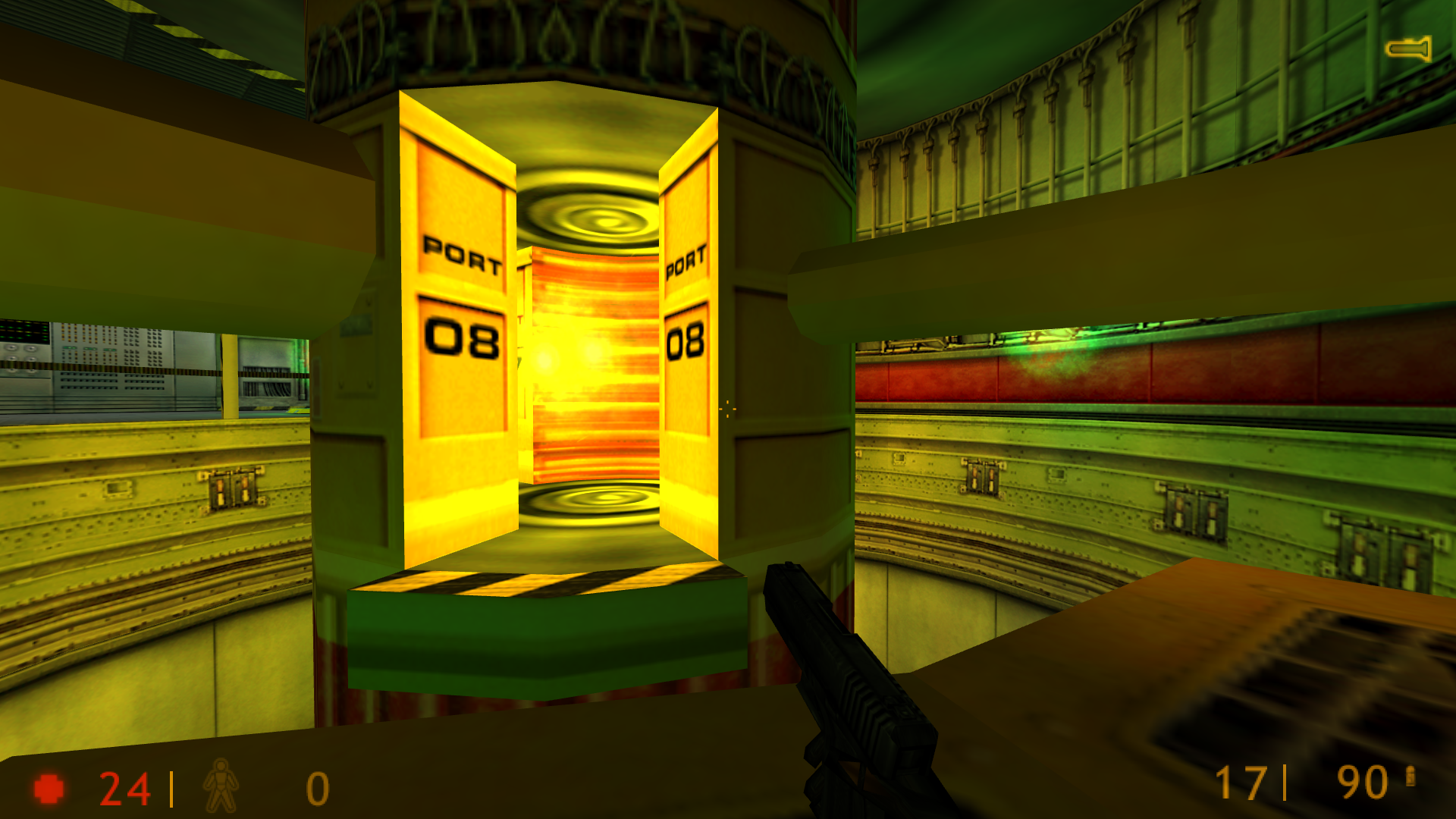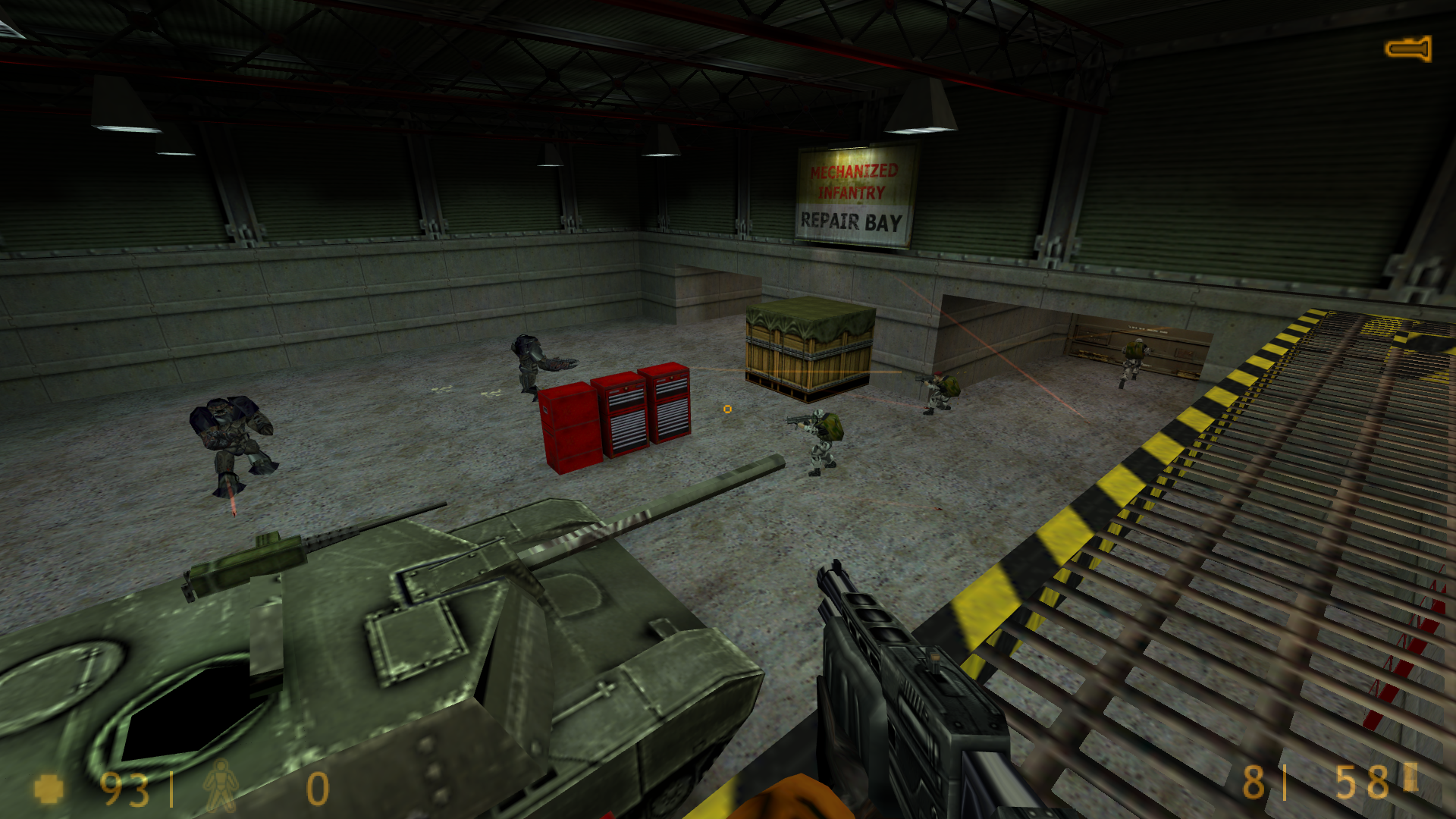Video Games
Half-Life At 25: Still One Of The Best
Valve's 1998 game Half-Life is a workplace comedy where nobody can seem to catch a break. A server crash, fucking with the microwave, and foreboding exploding terminals are a bad enough morning at Black Mesa. But of course, the routine experiment summons an alien invasion. Things go from bad to worse when the military gets involved. Ugh! When has the military ever made anything better? I sure hope Gordon Freeman has some PTO stocked up! He's gonna need it.

Half-Life is also a seminal classic and trend setter for a whole genre, if not the entire industry, in a decade that was filled with them. It's hard to understate the explosive development and iteration the FPS genre alone underwent between, say, 92's Wolfenstein 3D and 98's Half-Life. It what appears to us, now, to be six short years, Gabe Newell, Mike Harrington, and the team they would assemble for Valve, decided the FPS scene needed a shake up. The mindless shooting gallery was getting stale. It was time to put some horror and science fiction storytelling to work in a first-person action package.
My desire to replay Half-Life just happened to coincide with the 25th anniversary of the game. The new documentary that Valve themselves released goes over Half-Life's development and impact better than I really could, so, here you go.
I'll admit, the FPS genre is not usually my favorite. Not modern ones, anyway. After a sort of Golden Age on the PC (for my taste, this golden age is mostly over at Half-Life 2's release in 2004, and beings at DOOM's release in 1993), the genre kind of loses me. Too much has been lost and put out of balance for me. To put it another way, how many games am I supposed to play where I walk over to a dead body and press F steal all their stuff? I have never found a game that satisfies everything for me, though mind you this is no particular soul quest.
That's where Half-Life comes in, and has stayed in my mind since I originally played it some time in the early 10's, and replayed again a few years ago. Half-Life is just right, almost all of it. In my humble opinion with complete sincerity, this is the peak. Half-Life is filled with the powerful weapons, deadly firefights, and fast movement speed of a DOOM or Quake. It brings to fresh the table clever, sometimes understated cinematic storytelling, immutable atmosphere, all while never being bogged down in trying way too hard to be a movie for general audiences.
Take note of when I played Half-Life 1. It was in 2007 when the legendary Orange Box introduced me to Valve, Half-Life 2, and the eternal classic of my generation, Team Fortress 2. Oh, and Portal. Maybe next time. It would be a few years of TF2, Garry's Mod, and HL2 before I got to tackle HL1. And it still blew me away! It blows me away 25 years after its original release.
Were Half-Life solely, or primarily made up of its famous scripted sequences, like scientists jumping through windows, alien soldiers breaking out of captivity, being fire bombed in a duct, etc., that's one thing. Innovative for its time, but quaint today. But HL is more than happy to mix things up with two elements, broadly speaking. Dynamic enemy fights and lonely survival puzzle solving. Maybe that's more like three things.
The Marines. Or, as they are actually known, The Hazardous Environment Combat Unit. These enemies are among the most exciting to fight in any game I've played, even going beyond first person shooters. The Marines will attempt to flank you, communicate your position, and flush you out with grenades and gunfire if they catch you in a corner. You will be alerted to their presence through their iconic radio chatter and terrifying voices.

They are brutal. You've only got so many grenades and sneaking opportunities to try and take them out quickly. It'll be up to you when to rush, when to fall back, and how to use your resources. I'm quite fond of trying to make little traps with the Laser Trip Mines and listening to their delightful explosions safely around a corner.
I would like to mention an interesting fact about the technology that powers the HECU. On maps and rooms where they are involved, they have "suggestions" of what would be good cover, and other key points. This was divulged in clear terms in the new documentary by level designer Dave Riller at 46:41. I'd like to highlight this because it's a fantastic example of what Half-Life weaves so well. Is the AI 'faked' a little bit? Maybe? Does it still result in frantic firefights that rarely play out the same way twice! Yes! The Marines appear incredibly smart, and do make some decisions and react to their environment, but the game helps them get there. They also prioritize most aliens over Gordan Freeman, and can "hear" loud sounds. I greatly enjoy this kind of "meeting halfway" with their logic design. To a player, they react realistically and try their damnedest to kill you as quickly as possible.
Alien enemies are no slouch either though. While they don't seem to display the tactics and sheer murderous force of will the Marines might, each alien requires at least a mini-tactic to wisely defeat. Headcrabs are best strafed around, Zombies kept at bay, and Vortigaunt electric blasts have their specific timing to avoid. This ends up making a nice contrast between the two factions of foes, fighting one or the other feel nothing alike, and this often used to maintain a smooth pace of action in a level. A game with only Marines or only aliens of this variety would be lesser for it.
A non-insignificant amount of the game is made up of sequences with very few enemies, or none at all. You'll often be tasked with trying to find a way out of a particular area or remove immediate hazards that halt your progress. Gordon must climb plenty of ladders (and fall off of those ladders), crawl through vents and shafts, and flip on/off switches for various devices. These scenes are still novel and amusing, and "On A Rail" is a good integration of the two styles. Keeping the train with you and clearing the track is equal parts puzzle and monster/marine hideouts. "Residue Processing", meanwhile, is almost nothing but trying not to get killed in a foundry setting while you're naked and afraid. Half-Life's environment can be just as much an enemy as anything that shoots at you. The HEV suit alerts you of radiation, fire, electrical hazards, oxygen deprivation, or MAJOR FRACTURE DETECTED adds so much to the feeling of survival.
Half-Life's steady, linear rhythm is one of its assets. Levels are interconnected about 90% of the time, leaving the chapter system to guide players between stopping points and fresh objectives. The game ramps up from a crowbar and its simplest enemies into huge fights in "We've Got Hostiles" and "Power Up". Just when Gordon is fully powered and things seem to be going a bit too well, "Residue Processing" takes everything away for a while. It's a great way to keep the atmosphere and tension of being a lone scientist fighting in a world where nothing is as it seems.

By the time of Quicksave-... I mean, uh, "Surface Tension" however, Half-Life's scripted sequences and increase in difficulty might start to step a bit overboard. Surface Tension in particular is filled with packs of Marines, some of the strongest alien enemies, sniper towers, and general deathtraps left and right. If Half-Life has one weakness pre-Xen, it's this. These things keep the player on edge and observant of the environment, and succeed in creating that hostile, dangerous feeling. The game isn't making concessions to make sure you get through it. In that aspect, the final Black Mesa chapters kick ass. At the same time though, it is just so easy to make a left turn and get blasted by a tank, six Marines, or a hundred alien hornets. Or drop a car on yourself. Or walk into a landmine. You get the idea.
Getting through those scenarios, however many tries it may take, rewards one with a satisfying exhale as they tap the reload key (and/or the save key. We don't shame that here.) and find the next medkit. This is not exactly the case for the game's last hour or two, unfortunately.

Also, to this day I still do not have a full understanding of this thing in Lambda Core. Yes, they are teleporters on this spire thing, but how which entrance in the tower determines where you go, I am clueless. I got through it all the same, but it's a minor roadbump compared to what comes next. After the player gets through this, the Lambda team send Gordon through to the alien world Xen to try and put a stop to this, if he can survive.
And Xen What Happens?

Every time I replay this game. Every time. I think to myself "Xen wasn't really that bad. It's super cool! I love how freaky it is!" And I do...
Xen is, conceptually, a great finale for the game. The alien borderworld is an inspired place with freaky flora, fauna, and monsters galore. A lot of the game's sci-fi horror themes will apex here. Aliens are going to get more eldritch and twisted. The storytelling continues to be grand, with a scary voice entering Freeman's mind, and dead HEV suits that suggest previous explorations have gone horribly wrong. Or perhaps someone was extremely close to stopping the final boss before you? It honestly tickles the imagination.
It's one of the most discussed aspects of the game, and I'm afraid I have little counterpoint when it comes to the actual gameplay in Xen. While not completely devoid of cool, Half-Lifeish touches, Xen starts to fumble the ball with unintuitive objectives and a diminished sense of pacing.
These are levels and scenes where I start to make expletives like "What the fuck killed me?" and "Excuse me? That's so stupid!". Why are there hornet soldiers in barrels? Does this platform really have to rotate? It breaks my heart to say that, but to hide it would be dishonest. Half-Life does kind of fall apart at the end. In the new documentary, it was said "What you're getting is close to a first draft." I can't say it doesn't feel like it sometimes!
The Nihilanth is where I take a look at my monitor, and the devil on my shoulder whispers "Close enough". I think every time I have ever played this game, I have not killed the final boss the same way. There are glitches, optimizations (use the Crossbow on the crystals!), and general good strategy to take this down quick and have your date with the G-Man. It's very much like The Icon of Sin in DOOM II, where it is part puzzle and part enemy wave survival. Like the rest of Xen, I like it in concept. The rest of the game is filled with stealth, survival, and puzzles, so why not here? While I wouldn't say it's as hard as the DOOM ending, it's got everything unfun about Xen rolled into the game's last minutes. Have fun in the room with one texture (warning, this is a genuine eyesore), or figuring out that yes, you are damaging him with your regular weapons.

In Black Mesa, Half-Life is an action packed adventure with scares, thrills, and rewards both split second decision making and elaborate planning in fights. You need two hands to count all the memorable moments, and you'll start using your toes when you remember how slick you were for throwing detonation packs around corners and killing enemies with laser mines, and all the other moments you'll create. The raw emotion that Half-Life generates in its combat, its drama, and moment to moment gameplay, that magical symphony where I'm immersed in everything it offers, is still peerless in my heart. I feel that most future FPS games simply do not strike the chord this original game does at its peak. There are either too many setpieces and cutscenes that limit player participation (or at least the illusion of it), or a slaughterfest power fantasy where you are an invincible superhero with guns. There's nothing wrong with either of those ambitions, per say. I'm just trying to say that nothing, nothing, still, is quite like Half-Life despite imitators and its wide, WIDE influence. Nothing is exactly this.
To put it another way, Half-Life's original tagline was Run. Think. Shoot. Live.. Most games only get two or three of those in good form. Only Half-Life has mixed it all together so perfectly.
...In Xen, Half-Life is a messy, unfocused limp to the end. It might not stick out so bad if the rest of the game wasn't so damned good. It leaves a sadly bitter taste that is only saved from true disappointment by brevity, and a fascinating ending with the G-Man where you may exert some sense of will in accepting or declining his offer.
To anyone seeking an inventive thrill-ride with dynamic action and a riveting plot, Half-Life should still be a relevant consideration in today's gaming world. As of this writing Valve just finished giving away the game for free. While it seems like every person on planet Earth has played this game, I have a suspicion this game will continue to make new generations of fans. I was not really there in 1998, but come into it a decade later. A decade from that, now, I'm sure fresh faces are getting the same one-of-a-kind experience. The community around Valve's games is notoriously dedicated and contagious, and why should it be otherwise? Half-Life is an experience so memorable, and so ingrained in gaming culture that people are >still taking pleasure in discussing, playing, and revisiting it. So too will it be after 30, 35, and maybe even 40 years.
Happy Birthday, Half-Life. See you next time.
-JPL